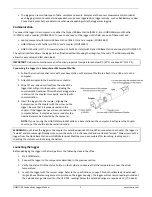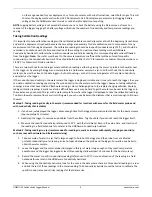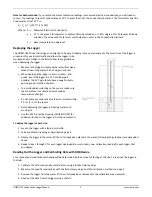
HOBO U24 Conductivity Logger Manual
4
onsetcomp.com
on the range needed for your deployment, or for environments with wide fluctuations, select both ranges. This will
shorten the deployment duration from 18,500 samples to 14,400 samples per parameter (not logging battery
voltage). See the
HOBOware User’s Guide
or online help for details on launching.
NOTE
: Logging battery voltage
is not essential because you can check the battery using the Status screen at launch or
readout of the logger. Logging the battery voltage will reduce the number of conductivity and temperature readings you
can log.
Taking Calibration Readings
It is important to take calibration readings with a calibrated portable conductivity meter at both the beginning (launchtime)
and end of a deployment (readout) because these readings are necessary for data calibration and to compensate for any
measurement drift during deployment. The calibration readings should be in specific conductance (at 25°C), and should be
recorded in a notebook with the time and location of the reading. You will use these readings in the HOBOware
Conductivity Assistant to calibrate the specific conductance and salinity readings for corresponding data series offloaded
from the logger.
Note:
The meter must be set to the same temperature coefficient that will be entered for specific
conductivity in the Conductivity Assistant. They should both be either 2.1%/°C for seawater or Sodium Chloride solutions or
1.8%/°C for Potassium Chloride solutions.
There are two methods for obtaining accurate calibration readings: either by placing the meter’s probe into the water next
to the logger or by placing the logger and meter probe in a field water sample in a jar. In both methods, the conductivity
meter probe must be close to the data logger—but not touching—so that it is measuring water at the same conductivity
and salinity as the logger.
If the conductivity and salinity in the water where the logger is deployed is stable and it is easy to reach the logger, then you
can obtain calibration readings by placing the probe directly into the water next to the logger. However, taking calibration
readings in areas that have tidal and freshwater mixing is more challenging due to the rapidly changing salinities. Similarly,
taking calibration readings in wells can also be difficult because it may be hard to get the meter probe next to the logger. In
these instances, you should fill a jar with a water sample from where the logger is deployed to take the calibration readings.
To obtain the water sample from a well or stilling well, you can use a bailer with a diameter that is small enough to fit down
the well.
Method 1: Taking readings directly in the water (recommended for locations with access for the field meter probe and
with conductivity that is stable)
1.
If you have just deployed the logger, allow enough time for the logger temperature to stabilize for the best accuracy
(approximately 15 minutes).
2.
Gently tap the logger to remove any bubbles from the surface. Tug the cable if you cannot reach the logger itself.
3.
Measure the specific conductivity, referenced to 25°C, with the field meter. Record the value, time, and location of
the reading in a field notebook for use later in the HOBOware Conductivity Assistant.
Method 2: Taking readings in a jar
(recommended for readings in wells or in water with rapidly changing conductivity,
such as areas with saltwater and freshwater mixing)
1.
Take a sample of water in a jar that is large enough to hold both the logger and the probe from a calibrated
portable conductivity meter, leaving an inch of space between the probe and the logger. For wells, use a bailer to
obtain the water sample.
2.
Leave the logger and the meter probe submerged in this jar of water long enough so they reach temperature
equilibrium and the logger has logged at least three readings (allow at least 15 minutes for the best accuracy).
3.
Record the meter’s specific conductivity reading (referenced to 25°C), time, and location of the reading in a field
notebook for use later in the HOBOware Conductivity Assistant.
4.
When using the Conductivity Assistant, look for the spot in the data where there are three similar readings in a row
and link the last of those readings to the meter reading. The Conductivity Assistant uses that value to calibrate the
specific conductance and salinity readings for that data series.






